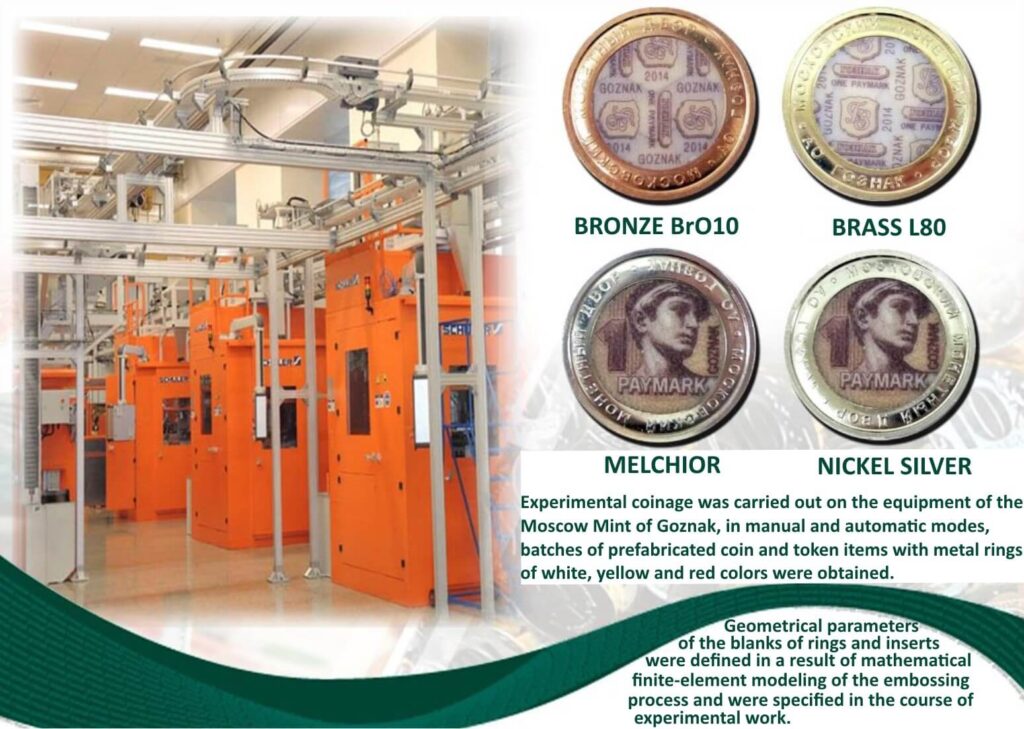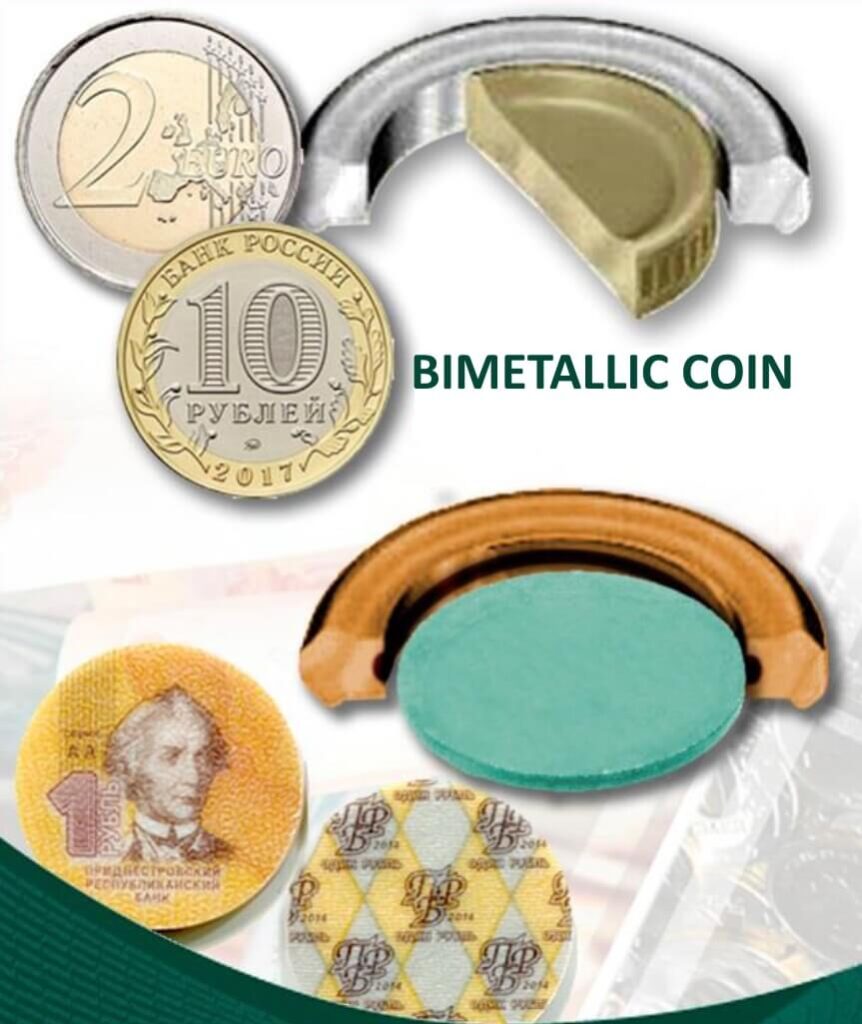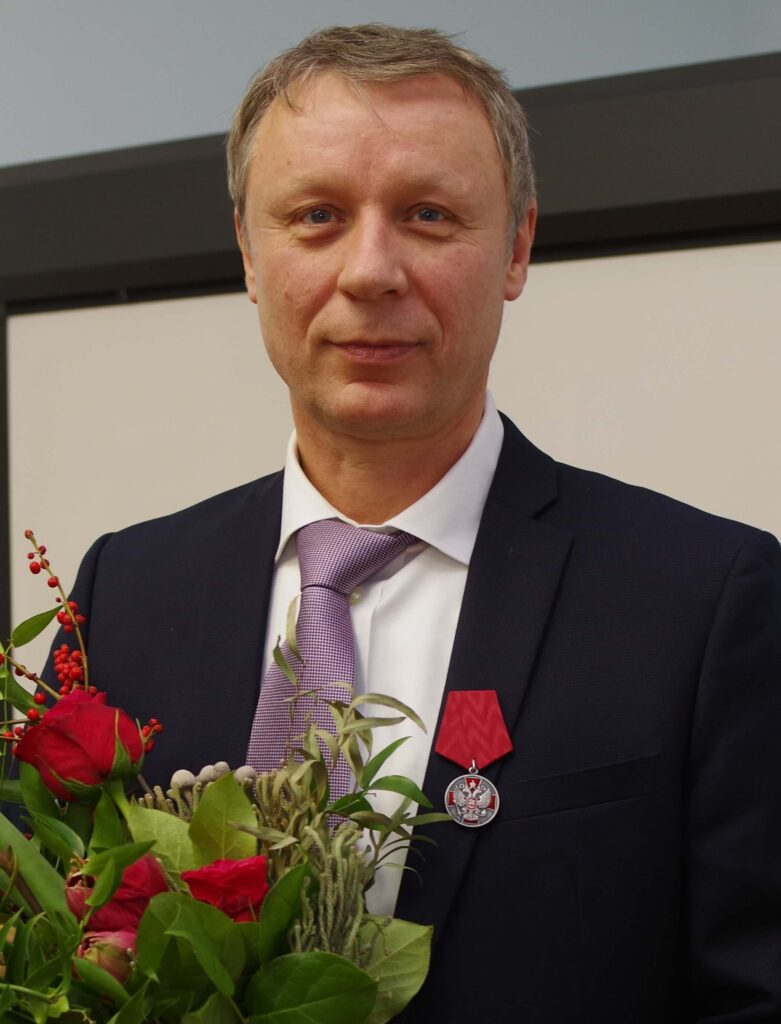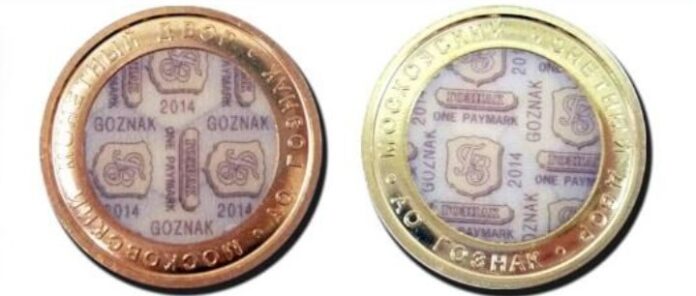The invention of “Plamet”
In 2014, Goznak proposed a revolutionary development – a material for a means of payment that combines advantages of both banknotes and coins.
This solution allows you to extend the lifetime of any means of payment to values comparable to the lifetime of coins (about 10 years), and retains the advantages of banknotes – bright, colorful design, high security degree, low weight and ease of use.
“Plamet” is an inert material that has some similarities with glass or tile by its characteristics. You can try to grow colonies of microbes on it, pour it with acid or alkali, wash it in a washing machine or in a dishwasher – none of these procedures will modify this material. If you tap an edge of a product made by this new technology on any surface, you can hear a sound similar to the one when you tap an edge of a ceramic roundel. This is not only a convincing proof of the difference of this composite material from plastic, which will never sound like ceramics, but also a confirmation that the material is as inert as ceramics.
The “Plamet” technology has already been applied in the manufacture of a means of payment put into circulation by the Pridnestrovian Republican Bank.
The launch of a separate manufacture for the mass production of the “Plamet” product is a large and complex project, which is underway. At first, deliveries of the production equipment should be carried out. Then the equipment installation stage will follow and its commissioning will begin. After this, Goznak will be ready for the mass production of the “Plamet” product. Presumably, the commercial operation of the equipment will begin at the end of 2019.

Successful tests
At the VIII Scientific and Technical Conference “New developments in the field of security technologies for materials and processes”, held annually by the Goznak Research Institute, Mikhail Rodionov, the Senior Researcher at the Monetary and Medallic Department of the Research Institute, made a sensational report in which he described a tool, with the help of which a new combined product will be minted for the first time in the world, using “Plamet” material.
Mikhail Rodionov showed the stages of the experiment, during which the scientists of the Research Institute found the only possible form of the instrument, with the help of which it is possible to mint a unique product, which represents a semblance of a bicolor coin. However, it is not the metal disk that is clamped in the metal ring, but the “Plamet” disk.

The tests were carried out on the equipment of the Moscow Mint in the mode of manual and automatic coinage. At first, when using a conventional embossing tool, the workpiece was deformed along the entire surface of the insert-disk: cracks and chips appeared on it.
But after a series of experiments with a special form of the embossing tool, it was possible to achieve a result in which the insert of the composite material was not deformed, and the ring of metal was closed around it in a strong lock. Experiments were carried out with metal rings made of cupronickel, brass, bronze and nickel silver.
The products have successfully passed the tests on changing the temperature mode (imitation of cycles of temperature difference during the “street-house” operation) and on physical extrusion.

The path from idea to its realization
The author of the idea of creating “Plamet” and a combined product with the use of “Plamet” is Andrey Kuryatnikov, Deputy General Director of Goznak for Science and Development.
In an interview with the Gold Chervonets Magazine, he spoke about the development and future application of “Plamet”.
Gold Chervonets Magazine: How did the idea of creating “Plamet”, as well as its combined product, appear?
Andrey Kuryatnikov: I constantly teach my students to be creative, because I teach the subject “Management of the innovation process, research and development” at the Finance Academy under the Government of the Russian Federation. As a matter of fact, there is nothing difficult about it. Techniques developed in order to generate ideas and technologies have existed for a long time. If you need to create a product that should have the benefits of another product, it is easy to do if you have several existing products already. Each of them has some positive and some negative properties. Accordingly, it is possible to design a model of a new product so that the positive properties remain and the negative ones do not.
The advantages of banknotes are obvious – they are well secured, easy to handle, have a beautiful design and a memorable color image.
Coins are heavy; the population doesn’t like them too much, not only in our country, but also in other countries. Their only advantage is durability. However, it is also a very relative term, because after six months or a year the appearance of the coins becomes rather unattractive: you may see metal corrosion and contamination on them. Such coins are even unpleasant to hold in hand. Nevertheless, they still retain their physical properties, in contrast to the rapidly deteriorating banknotes.
The development work that we present combines the advantages of both means of payment: lightness and elegance, usability and good security, the complete absence of corrosion and deterioration, and, as a result, durability.
First of all, the idea of a new means of payment was presented to the company’s management. At this stage, the product was perceived as extremely unusual. But I believe that there is nothing terrible about it. For a long time the world has been using polymer banknotes, which the population perceives adequately. It should be noted that the population accepts innovations more positively and faster than top managers.
The combined product with the use of “Plamet” is optimal in terms of combining the advantages of several different products. At the same time it is devoid of their shortcomings.
The product turned out even better than its original image. Thinking about the product, I understood what properties it will have. However, there were still doubts that it would be possible to overcome all the technical difficulties in implementing the idea. To our great satisfaction, we managed to solve them.
Gold Chervonets Magazine: When you developed this idea, what denominations of banknotes and coins seemed to you most suitable for replacing with a new product?
Andrey Kuryatnikov: High denomination coins and low denomination banknotes can be made from a combined product: insert-disk made of “Plamet” and a metal ring. And the coins of low denomination can be entirely made of the “Plamet” composite material.
Gold Chervonets Magazine: What if to compare the cost price of “Plamet” and its combined product with the cost price of production of banknotes and coins?
Andrey Kuryatnikov: Banknotes and coins have a very wide range of prices, depending on the material and elements of the security complex. We can say that the cost price of the new product can be close to a particular class of banknotes or coins, depending on the characteristics of the new product.
High durability is inherent in any of these products. Let me remind you that the banknotes are usually removed from circulation during the process of sorting, due to scuffs and dirt. “Plamet” is an inert material not subject to abrasion and contamination. The metal ring in the combined product is subject to the same impact as any metal coin. But at the same time, the durability of “Plamet” and the combined product made of it is even higher than that of coins. The security complex of these products can be as rich as that of banknotes, and include visible, ultraviolet and infrared images, security fibers, microtexts, color-variable images and other security features.
The perfect metal for the combined product needs to be quite plastic by its properties. This is the main requirement. The other characteristics of the metal can vary. It is possible to use both conventional alloys and powder materials. The last ones have a number of significant advantages. But for their application it is necessary to solve the problem with the equipment for mass production.

Gold Chervonets Magazine: Can the thickness of the combined product vary?
Andrey Kuryatnikov: As for the thickness of the coin, there is an optimal value, verified from the technical, logistic and design points of view. But, if necessary, the thickness of the “Plamet” in the combined product may be greater or less than the optimal values.
Gold Chervonets Magazine: At what enterprises of Goznak will combined products using “Plamet” be manufactured?
Andrey Kuryatnikov: Combined product in the process of its production will go through many stages: the stage of production of the original fiber cloth and the stage of its impregnation, the stage of preparation of the intermediate product (at the paper mill), the stage of printing (at the printing factory), the stage of coinage or combination of composite material with metal (in the mint). This process is a multi-stage one.
Gold Chervonets Magazine: Will collectors collect combined products, as they collect coins?
Andrey Kuryatnikov: We have plans to release a collector’s coin that will be a combined product made of “Plamet” and metal. I am sure that it will be in demand among collectors. Actually, there are a number of interesting ideas with a combined product, and in the near future we will bring them to life.

This article was first published in the Gold Chervonets Magazine. We are grateful to our Russian colleagues for their willingness to share their information with us.
Gold Chervonets Magazine is the only magazine in Russia about the coin market. It organizes the International conference and exhibition COINS and the International contest “Coin Constellation”.
Do we need new technologies for minting coins? Does cash even have a future? CoinsWeekly reported about CashCon 2019, discussing all aspects of cash.
We also published an article about the winners of the Russian “Coin Constellation 2018” contest.



